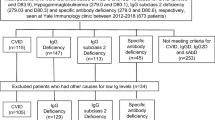Abstract
Objectives
To investigate the immunological phenotypes detected in children with recurrent upper and lower respiratory infections that have normal total immunoglobulin concentrations.
Methods
A cohort of over 60 children with recurrent respiration infections was evaluated for specific antibody deficiencies (SAD) and for memory B-cell abnormalities. A control group of children without recurrent infections was also evaluated. Evaluation included a detailed history of immunizations with pneumococcal vaccines; determination of IgM, IgG, IgA, and IgE concentrations; measurement of anti-pneumococcal polysaccharide antibody levels by ELISA and expression of CD27, IgD, and IgM on peripheral CD19+B cells by flow cytometry to determine the proportions of naive, IgM-memory B cells, and class-switched memory B cells.
Results
Patients were classified as having a SAD to either pure polysaccharides (PPV-SAD) or to conjugate polysaccharides (PCV-SAD) based on the number of polysaccharides to which they developed an adequate antibody response. A normal response to only 2 or fewer of 7 PCV or PPV serotypes was considered as evidence of SAD. Forty-one patients without SAD and 26 with SAD were identified. IgM-memory B cells were low in 3 of 41 patients without SAD; in 3 of 5 PPV-SAD patients; and in 10 of 21 PCV-SAD patients. Class-switched memory B cells were low in 19 of 41 patients without SAD; in all 5 patients with PPV-SAD; and in 11 of 21PCV-SAD patients.
Conclusions
Patients with recurrent infection with or without SAD may have low IgM- and/or class-switched memory B cells. Ongoing research aims to determine the prognostic implications of these differences in patients with SAD.


Similar content being viewed by others
References
Knutsen AP. Patients with Igg subclass and/or selective antibody deficiency to polysaccharide antigens: initiation of a controlled clinical trial of intravenous immune globulin. J Allergy Clin Immunol. 1989;84(4 Pt 2):640–5. discussion 645–7.
Warnatz K, Denz A, Drager R, Braun M, Groth C, Wolff-Vorbeck G, et al. Severe deficiency of switched memory B cells (CD27(+)IgM(−)IgD(−)) in subgroups of patients with common variable immunodeficiency: a new approach to classify a heterogeneous disease. Blood. 2002;99(5):1544–51.
Sanz I, Wei C, Lee FE, Anolik J. Phenotypic and functional heterogeneity of human memory B cells. Semin Immunol. 2008;20(1):67–82.
Alachkar H, Taubenheim N, Haeney MR, Durandy A, Arkwright PD. Memory switched B cell percentage and not serum immunoglobulin concentration is associated with clinical complications in children and adults with specific antibody deficiency and common variable immunodeficiency. Clin Immunol. 2006;120(3):310–8.
Agematsu K, Nagumo H, Shinozaki K, Hokibara S, Yasui K, Terada K, et al. Absence of IgD-CD27(+) memory B cell population in X-linked hyper-IgM syndrome. J Clin Invest. 1998;102(4):853–60.
Piqueras B, Lavenu-Bombled C, Galicier L, Bergeron-van der Cruyssen F, Mouthon L, Chevret S, et al. Common variable immunodeficiency patient classification based on impaired B cell memory differentiation correlates with clinical aspects. J Clin Immunol. 2003;23(5):385–400.
Carsetti R, Rosado MM, Donnanno S, Guazzi V, Soresina A, Meini A, et al. The loss of IgM memory B cells correlates with clinical disease in common variable immunodeficiency. J Allergy Clin Immunol. 2005;115(2):412–7.
Ko J, Radigan L, Cunningham-Rundles C. Immune competence and switched memory B cells in common variable immunodeficiency. Clin Immunol. 2005;116(1):37–41.
Orange JS, Ballow M, Stiehm ER, Ballas ZK, Chinen J, De La Morena M, et al. Use and interpretation of diagnostic vaccination in primary immunodeficiency: a working group report of the basic and clinical immunology interest section of the American academy of allergy, asthma & immunology. J Allergy Clin Immunol. 2012;130(3 Suppl):S1–24.
Sorensen R, Leiva L, Javier F, Sacerdote D, Bradford N, Butler B, et al. Influence of age on the response to Streptococcus pneumoniae vaccine in patients with recurrent infections and normal immunoglobulin concentrations. J Allergy Clin Immunol. 1998;102:215–21.
Paris K, Sorensen RU. Assessment and clinical interpretation of polysaccharide antibody responses. Ann Allergy Asthma Immunol. 2007;99(5):462–4.
Ferry BL, Jones J, Bateman EA, Woodham N, Warnatz K, Schlesier M, et al. Measurement of peripheral B cell subpopulations in common variable immunodeficiency (CVID) using a whole blood method. Clin Exp Immunol. 2005;140(3):532–9.
Agematsu K, Nagumo H, Yang FC, Nakazawa T, Fukushima K, Ito S, et al. B cell subpopulations separated by CD27 and crucial collaboration of CD27+ B cells and helper T cells in immunoglobulin production. Eur J Immunol. 1997;27(8):2073–9.
Agematsu K, Kobata T, Yang FC, Nakazawa T, Fukushima K, Kitahara M, et al. CD27/CD70 Interaction directly drives B cell IgG and IgM synthesis. Eur J Immunol. 1995;25(10):2825–9.
Kruetzmann S, Rosado MM, Weber H, Germing U, Tournilhac O, Peter HH, et al. Human immunoglobulin M memory B cells controlling Streptococcus pneumoniae infections are generated in the spleen. J Exp Med. 2003;197(7):939–45.
Tangye SG, Good KL. Human IgM + CD27+ B cells: memory B cells or “memory” B cells? J Immunol. 2007;179(1):13–9.
Vinuesa CG, Sze DM, Cook MC, Toellner KM, Klaus GG, Ball J, et al. Recirculating and germinal center B cells differentiate into cells responsive to polysaccharide antigens. Eur J Immunol. 2003;33(2):297–305.
Huck K, Feyen O, Ghosh S, Beltz K, Bellert S, Niehues T. Memory B-cells in healthy and antibody-deficient children. Clin Immunol. 2009;131(1):50–9.
Smet J, Mascart F, Schandene L. Are the reference values of B cell subpopulations used in adults for classification of common variable immunodeficiencies appropriate for children? Clin Immunol. 2011;138(3):266–73.
Siber GR. Pneumococcal disease: prospects for a new generation of vaccines. Science. 1994;265(5177):1385–7.
Pletz MW, Maus U, Krug N, Welte T, Lode H. Pneumococcal vaccines: mechanism of action, impact on epidemiology and adaption of the species. Int J Antimicrob Agents. 2008;32(3):199–206.
Acknowledgments
This work was partially supported by Talecris Biotherapeutics and The Jeffrey Modell Diagnostic Center for Primary Immunodeficiencies.
Conflict of Interest
The authors declare that they have no conflict of interest.
Author information
Authors and Affiliations
Corresponding author
Rights and permissions
About this article
Cite this article
Leiva, L.E., Monjure, H. & Sorensen, R.U. Recurrent Respiratory Infections, Specific Antibody Deficiencies, and Memory B Cells. J Clin Immunol 33 (Suppl 1), 57–61 (2013). https://doi.org/10.1007/s10875-012-9814-9
Received:
Accepted:
Published:
Issue Date:
DOI: https://doi.org/10.1007/s10875-012-9814-9




